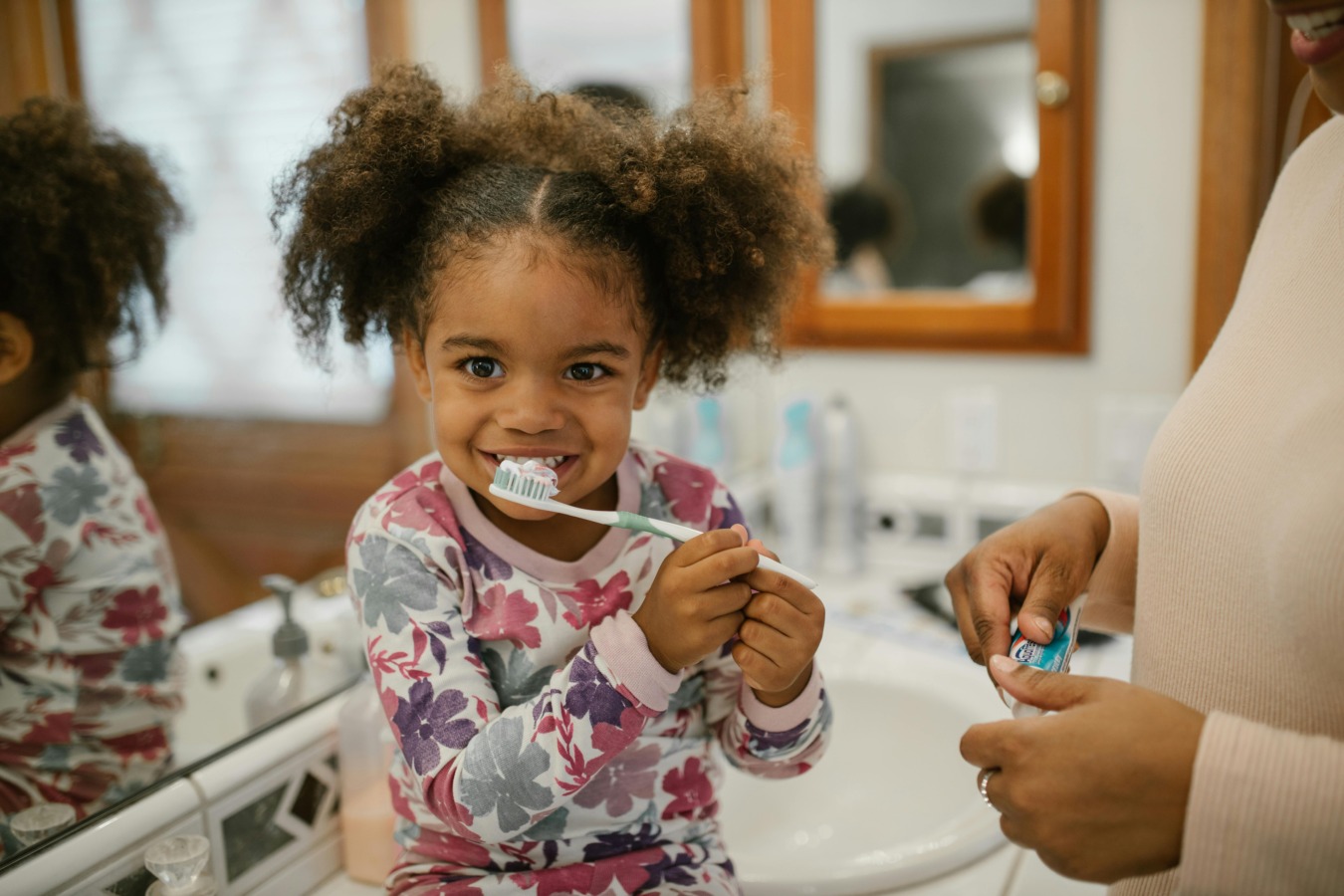
Oral health for children
We want to help parents and caregivers keep kids’ smiles healthy. We have tips on how to brush and floss correctly, advice on looking after baby teeth and picking healthy foods and drinks.
Oral Health for babies: 6 months to 3 years old
Your health visitor will introduce you to Happy Teeth, Healthy Smiles. They will give you oral health advice and provide you with free toothbrushes and toothpaste with at least 1450 parts per million (ppm) fluoride.
Caring for your baby’s first teeth
Your baby’s first tooth comes through around the age of six months, but it can start earlier or later than this. It’s important to protect your child’s first teeth against decay so that their adult teeth have a chance to fully develop before they come through.
It’s never too early to start caring for your baby’s teeth – visit your dentist with your child regularly for dental checks.
Here are some tips to protect your baby’s teeth:
- Brush your baby’s teeth as soon as their first tooth appears
- Brush at least twice a day; in the morning and just before going to bed
- For children under three years of age use a smear of toothpaste on the brush. Use toothpaste containing at least 1450 parts per millions (ppm) fluoride
- After brushing “spit, don’t rinse” – this gives the toothpaste time to work to protect teeth
- Take your child to see the dentist before they are one year old and go regularly
- Ask your dentist about fluoride varnish
- Limit sugary drinks and snacks to mealtimes only
Baby’s first drink
You may choose to breastfeed your baby or give formula milk. Your health visitor will be able to give you advice and information to help you decide.
Breastfeeding
Breastfeeding is beneficial to you and your baby. Any amount of breastfeeding is positive and the longer you can breast feed your baby, the greater the benefits are.
Breast feeding can reduce the risk of:
- Your baby being overweight in childhood and adulthood
- Diabetes, asthma and eczema in later life
- Sudden Infant Death Syndrome (SIDS)
Your midwife, health visitor and GP will be able to direct you to local breastfeeding support.
Formula milk
Formula milk provides babies with the nutrients they need to grow and develop. However, it does not have the same health benefits as breastfeeding for you and your baby. For example, it cannot protect your baby from infections.
Your midwife, health visitor and GP will be able to help you decide if formula milk is the right choice for you and your baby.
More information about formula milk can be found on the Health for Under 5’s website.
Drinking from a cup
Using a bottle for a prolonged time can children’s issues with their teeth. Learning to drink from a cup can be messy and fun, but it’s all part of growing up.
When should a child start drinking from a cup?
Introduce drinking from a cup from 6 months of age. Using a cup is better for your baby’s teeth and prolonged bottle feeding can cause tooth decay. Aim to stop bottle feeding by one years old.
What is the best kind of cup for my child?
Choosing a free flow cup is best. Free flow cups allow water or milk to drip from the spout when turn upside down.
When should I give my child a drink?
Never give your baby sugary drinks last thing at night or during the night if they wake, you should only give them water at these times. Do not put any sweet drinks (including fruit juice) in a bottle as this can cause rapid tooth decay, giving them water or milk in a bottle is best.
Oral health for 3 to 6 year olds
Between three and six years old, your child will be on the way to having all 20 baby teeth and toothbrushing should be a twice-daily routine.
They will be starting to discover new food and drinks at home, nursery, or school, so it’s important to think about how much sugar is in their meals and snacks. Encouraging them to brush their teeth and reducing the amount of sugar will prevent tooth decay.
Continue to visit your dentist with your child regularly for dental checks.
Here are some tips to protect your child’s teeth:
- Supervise and help your child as they brush their teeth
- Brush at least twice a day; in the morning and just before going to bed
- For children aged three years and above, use a pea-sized amount. Use toothpaste containing at least 1450 parts per millions (ppm) fluoride
- After brushing “spit, don’t rinse” – this gives the toothpaste time to work to protect teeth
- Eat healthy food and only have sweet food and drinks with meals.
- Take your child to see the dentist regularly
- Ask your dentist about fluoride varnish.
- Ask your nursery or school about supervised toothbrushing[MB2] .
Fluoride varnish
Research shows that fluoride varnish is highly effective at reducing tooth decay if it is applied twice a year. Fluoride varnish should be applied at least twice-yearly to all children.
What is fluoride?
Fluoride is a mineral that helps to prevent tooth decay. It can be found in toothpaste and fluoride varnish.
What is fluoride varnish and what is it used for?
Fluoride varnish is a gel that is painted onto children’s teeth using a soft brush, which sets quickly.
Where can I get fluoride varnish for my children?
Fluoride varnish is applied to the teeth at the dental practice by a member of the dental team. The benefits of fluoride varnish last for several months, after which it needs to be reapplied.
Find an NHS Dentist
If you’re looking for a dentist in your area, you can search for a dentist on the NHS find a dentist website.
